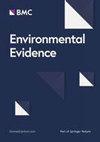Existing evidence on the effects of climate variability and climate change on ungulates in North America: a systematic map
IF 5.2
4区 环境科学与生态学
Q2 ENVIRONMENTAL SCIENCES
引用次数: 0
Abstract
Climate is an important driver of ungulate life-histories, population dynamics, and migratory behaviors. Climate conditions can directly impact ungulates via changes in the costs of thermoregulation and locomotion, or indirectly, via changes in habitat and forage availability, predation, and species interactions. Many studies have documented the effects of climate variability and climate change on North America’s ungulates, recording impacts to population demographics, physiology, foraging behavior, migratory patterns, and more. However, ungulate responses are not uniform and vary by species and geography. Here, we present a systematic map describing the abundance and distribution of evidence on the effects of climate variability and climate change on native ungulates in North America. We searched for all evidence documenting or projecting how climate variability and climate change affect the 15 ungulate species native to the U.S., Canada, Mexico, and Greenland. We searched Web of Science, Scopus, and the websites of 62 wildlife management agencies to identify relevant academic and grey literature. We screened English-language documents for inclusion at both the title and abstract and full-text levels. Data from all articles that passed full-text review were extracted and coded in a database. We identified knowledge clusters and gaps related to the species, locations, climate variables, and outcome variables measured in the literature. We identified a total of 674 relevant articles published from 1947 until September 2020. Caribou (Rangifer tarandus), elk (Cervus canadensis), and white-tailed deer (Odocoileus virginianus) were the most frequently studied species. Geographically, more research has been conducted in the western U.S. and western Canada, though a notable concentration of research is also located in the Great Lakes region. Nearly 75% more articles examined the effects of precipitation on ungulates compared to temperature, with variables related to snow being the most commonly measured climate variables. Most studies examined the effects of climate on ungulate population demographics, habitat and forage, and physiology and condition, with far fewer examining the effects on disturbances, migratory behavior, and seasonal range and corridor habitat. The effects of climate change, and its interactions with stressors such as land-use change, predation, and disease, is of increasing concern to wildlife managers. With its broad scope, this systematic map can help ungulate managers identify relevant climate impacts and prepare for future changes to the populations they manage. Decisions regarding population control measures, supplemental feeding, translocation, and the application of habitat treatments are just some of the management decisions that can be informed by an improved understanding of climate impacts. This systematic map also identified several gaps in the literature that would benefit from additional research, including climate effects on ungulate migratory patterns, on species that are relatively understudied yet known to be sensitive to changes in climate, such as pronghorn (Antilocapra americana) and mountain goats (Oreamnos americanus), and on ungulates in the eastern U.S. and Mexico.气候多变性和气候变化对北美有蹄类动物影响的现有证据:系统地图
气候是有蹄类动物生命史、种群动态和迁徙行为的重要驱动因素。气候条件可通过体温调节和运动成本的变化直接影响有蹄类动物,或通过栖息地和饲料可用性、捕食和物种相互作用的变化间接影响有蹄类动物。许多研究记录了气候多变性和气候变化对北美有蹄类动物的影响,记录了对种群数量、生理、觅食行为、迁徙模式等的影响。然而,有蹄类动物的反应并不一致,而且因物种和地理位置而异。在此,我们提供了一份系统地图,描述了气候变异和气候变化对北美本地有蹄类动物影响的证据的丰富程度和分布情况。我们搜索了所有记录或预测气候多变性和气候变化如何影响美国、加拿大、墨西哥和格陵兰岛 15 种原生有蹄类动物的证据。我们搜索了 Web of Science、Scopus 和 62 个野生动物管理机构的网站,以确定相关的学术文献和灰色文献。我们对英文文献进行了标题、摘要和全文的筛选。我们从所有通过全文审查的文章中提取数据,并在数据库中进行编码。我们确定了与文献中测量的物种、地点、气候变量和结果变量相关的知识集群和差距。我们共发现了 674 篇从 1947 年到 2020 年 9 月发表的相关文章。驯鹿(Rangifer tarandus)、麋鹿(Cervus canadensis)和白尾鹿(Odocoileus virginianus)是研究最多的物种。从地域上看,美国西部和加拿大西部开展的研究较多,但研究也主要集中在五大湖区。与温度相比,研究降水对有蹄类动物影响的文章要多出近 75%,与雪有关的变量是最常测量的气候变量。大多数研究都探讨了气候对有蹄类动物种群数量、栖息地和饲料、生理和状况的影响,而探讨对干扰、迁徙行为、季节范围和走廊栖息地的影响的研究则少得多。气候变化的影响及其与土地使用变化、捕食和疾病等压力因素的相互作用日益受到野生动物管理者的关注。本系统地图范围广泛,可帮助蹄类动物管理者识别相关的气候影响,并为他们所管理的种群的未来变化做好准备。有关种群控制措施、补充饲养、迁移和栖息地处理的决策,只是更好地了解气候影响后做出的部分管理决策。该系统地图还发现了文献中的一些空白,这些空白将受益于更多的研究,包括气候对有蹄类动物迁徙模式的影响、对研究相对不足但已知对气候变化敏感的物种(如长角马(Antilocapra americana)和山羊(Oreamnos americanus))的影响,以及对美国东部和墨西哥有蹄类动物的影响。
本文章由计算机程序翻译,如有差异,请以英文原文为准。
求助全文
约1分钟内获得全文
求助全文
来源期刊

Environmental Evidence
Environmental Science-Management, Monitoring, Policy and Law
CiteScore
6.10
自引率
18.20%
发文量
36
审稿时长
17 weeks
期刊介绍:
Environmental Evidence is the journal of the Collaboration for Environmental Evidence (CEE). The Journal facilitates rapid publication of evidence syntheses, in the form of Systematic Reviews and Maps conducted to CEE Guidelines and Standards. We focus on the effectiveness of environmental management interventions and the impact of human activities on the environment. Our scope covers all forms of environmental management and human impacts and therefore spans the natural and social sciences. Subjects include water security, agriculture, food security, forestry, fisheries, natural resource management, biodiversity conservation, climate change, ecosystem services, pollution, invasive species, environment and human wellbeing, sustainable energy use, soil management, environmental legislation, environmental education.
 求助内容:
求助内容: 应助结果提醒方式:
应助结果提醒方式:


